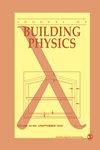Vapour resistance of wind barrier tape: Laboratory measurements and hygrothermal performance implications
IF 1.4
4区 工程技术
Q3 CONSTRUCTION & BUILDING TECHNOLOGY
引用次数: 4
Abstract
In the building industry, the interest into adhesive tape to achieve a more tight and robust building envelope has increased rapidly in recent years. With an increasing demand for energy efficiency in buildings, national building authorities are strengthening building requirements to mitigate and adapt to future climate impacts. This paper studies the water vapour permeability of adhesive tape for building purposes. A water vapour permeable wind barrier is essential to enable drying of the external side of the building envelope. Laboratory measurements have been conducted to evaluate how the drying conditions of the wind barrier layer are affected by the use of wind barrier tape. The results show that all the wind barrier tapes tested can be defined as significantly more vapour tight than the wind barrier itself. The wind barrier used as reference was found to have an sd-value of 0.03 m while tape ranged between 1.1 and 9.24 m. To ensure adequate drying and minimize the risk of moisture damages, the wind barrier layer should be vapour open. In an investigated construction project, the amount of tape constitutes 13% of the area of the building’s wind barrier. Further simulations need to be conducted to accurately determine the drying conditions and the following consequences.风障胶带的抗蒸汽性:实验室测量和湿热性能含义
在建筑行业,近年来对胶带的兴趣迅速增加,以实现更紧密和坚固的建筑围护结构。随着对建筑能效的需求不断增加,各国建筑主管部门正在加强建筑要求,以减轻和适应未来的气候影响。对建筑用胶带的透气性进行了研究。可透水的防风屏障对于使建筑围护结构的外部干燥至关重要。已经进行了实验室测量,以评估使用风障胶带对风障层干燥条件的影响。结果表明,所有测试的风障胶带都可以定义为比风障本身具有更强的蒸汽密封性。作为参考的风障的sd值为0.03 m,而胶带的sd值在1.1 - 9.24 m之间。为了确保足够的干燥和减少水分损坏的风险,防风层应该是开放的。在一个被调查的建筑项目中,胶带的数量占建筑物风障面积的13%。进一步的模拟需要进行,以准确地确定干燥条件和以下后果。
本文章由计算机程序翻译,如有差异,请以英文原文为准。
求助全文
约1分钟内获得全文
求助全文
来源期刊

Journal of Building Physics
工程技术-结构与建筑技术
CiteScore
5.10
自引率
15.00%
发文量
10
审稿时长
5.3 months
期刊介绍:
Journal of Building Physics (J. Bldg. Phys) is an international, peer-reviewed journal that publishes a high quality research and state of the art “integrated” papers to promote scientifically thorough advancement of all the areas of non-structural performance of a building and particularly in heat, air, moisture transfer.
 求助内容:
求助内容: 应助结果提醒方式:
应助结果提醒方式:


